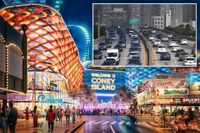Tempers are flaring in Brooklyn’s Coney Island as a $3 billion casino resort proposal, known as The Coney, faces mounting criticism from residents, community leaders, and environmental advocates. Backed by a partnership of Thor Equities, Saratoga Casino Holdings, Chickasaw Nation’s Global Gaming Solutions, and Legends Hospitality Group (which is part-owned by the New York Yankees), the project is vying for one of three coveted casino licenses that the state will award in the New York City area by the end of 2025.
The ambitious plan would transform a stretch of Surf Avenue from West 12th to West 15th streets into a glitzy entertainment complex, featuring a 500-room hotel, a convention center, a concert venue, and a casino. But at a pivotal July 30 Community Advisory Committee (CAC) meeting, the project’s environmental and social costs took center stage—and not in a good way.
Marissa Solomon, a Coney Island resident and CAC member appointed by Assemblyman Alec Brook-Krasny, pulled no punches in her critique. "It’s not just going to be the summer of hell. It will be traffic hell all year round, and garbage hell, noise hell, crime hell," Solomon told The New York Post. She went on to read directly from the project’s Final Environmental Impact Statement (FEIS), which painted a dire picture of the neighborhood’s future if the casino is built.
The FEIS revealed that The Coney would generate a staggering 27,000-plus trips per weekday across all transit modes—cars, taxis, trucks, public transit, and pedestrians. On Saturdays, that number would climb to nearly 30,000. During peak hours, the projections are even more daunting: 1,573 additional vehicles during weekday evening rush (5–6 p.m.), and 1,893 extra vehicles on Saturday afternoons—numbers that could overwhelm Coney Island’s already strained infrastructure. The FEIS reviewed 47 intersections and 24 highway segments, identifying multiple bottlenecks and downgrades to Level of Service (LOS) F—the technical term for gridlock—at key locations like the Belt Parkway (both eastbound and westbound), the westbound off-ramp between Coney Island Avenue and East 7th Street, and the intersection of Surf Avenue and Stillwell Avenue, where pedestrian delays could stretch beyond six minutes per traffic signal cycle.
Solomon’s concerns were echoed by others on the CAC, a six-member body whose approval is required for the project to advance. The panel includes representatives for Governor Kathy Hochul, Mayor Eric Adams, Brooklyn Borough President Antonio Reynoso, state Senator Jessica Scarcella-Spanton, Councilman Justin Brannan, and Solomon herself. If just three members vote against the casino, the bid is dead in the water.
Parking, always a hot-button issue in New York, is another major sticking point. The Coney plans to provide 1,500 on-site parking spaces—far fewer than Resorts World New York’s 7,000 spaces, for comparison. But FEIS data shows peak demand will hit 2,346 vehicles on weekdays (an 846-space shortfall) and 2,412 vehicles on Saturdays (a 912-space deficit). Surveys of parking within a half-mile radius indicate that, even outside the busy summer season, utilization would soar to 93% on weekday evenings and a whopping 109% during Saturday overnights. In the summer, these numbers climb even higher, virtually guaranteeing that visitors will spill into residential streets in search of parking.
Critics also warn that some of the off-site lots cited in the FEIS are themselves slated for future development or are controlled by the Department of Motor Vehicles, raising doubts about their long-term availability. "Your own transportation study said there would be significant adverse impacts at multiple intersections… and your only mitigation is two new lights and some new stripes? Really?" Solomon asked pointedly during the July 30 meeting. "Is that going to be able to handle what your own report says is a complete breakdown in traffic?"
The developers, however, insist they have a plan to keep Coney Island moving. Robert Cornegy, a former Brooklyn councilman and spokesperson for The Coney, told The New York Post, "The Coney will make massive once in a lifetime improvements to Coney Island’s transit accessibility after decades of neglect by adopting and improving the Stillwell Ave subway station, easing traffic flow through rerouting streets, aligning traffic lights, hiring traffic cops and funding infrastructure investments like a new ferry." He added, "In addition, we’re also going to offer discounted or complimentary round-trip subway fares for guests and employees and partner with the MTA to provide express subway service directly from Manhattan to Coney Island—all things that will help get people out of cars while also helping improve Coney Island."
Still, the FEIS is blunt about the limits of these mitigation efforts. Even after installing new traffic signals, re-striping streets, adding stop signs, hiring traffic officers, and upgrading the Stillwell Avenue subway station, several Belt Parkway segments and intersections—including Surf Avenue and Stillwell Avenue—are projected to remain at LOS F during peak hours. Unlike some competing casino bids, such as the Metropolitan Park proposal in Queens, The Coney does not include any physical expansion of the Belt Parkway or major new road infrastructure.
The project’s backers are also touting other measures, like shuttle buses from Manhattan and area airports, and renewed advocacy for a long-discussed Coney Island ferry route. Yet, as gaming industry insiders note, it remains an open question whether high-roller gamblers will swap their luxury vehicles for subway rides, no matter how express or discounted.
Community opposition is fierce and organized. Luna Park Amusement and Community Board 13 have both come out against the casino, with Luna Park’s website promoting a petition that reads, "Casinos are not engines of sustainable development—they are predatory institutions that exploit financial vulnerability, depress surrounding businesses, and increase social burdens such as crime, addiction, and poverty. Coney Island deserves investment in education, healthcare, and small business support—not a casino that siphons wealth from the community under the guise of economic development." The petition further argues, "The future of Coney Island should be shaped by its residents, not dictated by corporate developers behind closed doors."
As the debate rages, the stakes couldn’t be higher. If the CAC votes to approve The Coney, the bid will advance to the New York Gaming Facility Location Board, which will evaluate all applicants and recommend up to three for licensing. The final decision rests with the state Gaming Commission. But with community opposition mounting and the FEIS laying bare the project’s potential downsides, The Coney’s path to approval looks anything but certain.
For now, Coney Island’s future hangs in the balance—caught between visions of economic revitalization and the realities of urban congestion, community identity, and public trust. The coming months will reveal whether the neighborhood’s voice can tip the scales, or if the allure of casino dollars will win the day.




